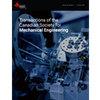基于粒子群优化算法的切削振动与切削热能量功率密度耦合特性研究
IF 1
4区 工程技术
Q4 ENGINEERING, MECHANICAL
Transactions of The Canadian Society for Mechanical Engineering
Pub Date : 2022-08-30
DOI:10.1139/tcsme-2022-0022
引用次数: 0
摘要
切削热和切削振动是机械加工领域的重要基础研究课题。影响切削热和切削振动的因素很多,切削热和加工振动也相互影响。本文主要从能量功率密度的角度研究了切削振动与切削热的耦合特性。建立了一个测量系统,用于采集切削温度和三维切削振动的时域信号。通过Stefan–Boltzmann定律,得到了以切削温度表示的切削热功率密度。对三维振动加速度进行了处理自功率谱密度的频域分析,并通过主成分分析进行了降维操作。基于粒子群优化算法,建立了切削热与切削振动的耦合模型。研究表明,切削热与切削振动的耦合相关系数在0.6以上。切削热与切削振动的耦合特性较强,切削振动对切削热的影响更为显著。这些结论为从能量角度研究切削热与切削振动的耦合特性提供了理论指导。本文章由计算机程序翻译,如有差异,请以英文原文为准。
Research on the coupling characteristics of energy power density of cutting vibration and cutting heat based on the particle swarm optimization algorithm
Cutting heat and cutting vibration are important basic research topics in the field of machining. Many factors affect cutting heat and cutting vibration, and cutting heat and cutting vibration also affect each other. This paper mainly studied the coupling characteristics between cutting vibration and cutting heat from the perspective of energy power density. A measurement system was built to collect the time-domain signals of cutting temperature and three-dimensional cutting vibration. Through Stefan–Boltzmann's law, the cutting thermal power density represented by the cutting temperature was obtained. Frequency domain analysis dealing with the self-power spectrum density was carried out on the three-dimensional vibration acceleration, and the operation of reducing the vibration dimension was carried out by principal component analysis. Based on the particle swarm optimization algorithm, two coupling models between cutting heat and cutting vibration were established. The research showed that the coupling correlation coefficient between cutting heat and cutting vibration was above 0.6. The coupling characteristics of cutting heat and cutting vibration were strong, and the impact of cutting vibration on cutting heat was more significant. The conclusions provide theoretical guidance for studying the coupling characteristics of cutting heat and cutting vibration from the energy perspective.
求助全文
通过发布文献求助,成功后即可免费获取论文全文。
去求助
来源期刊
CiteScore
2.30
自引率
0.00%
发文量
53
审稿时长
5 months
期刊介绍:
Published since 1972, Transactions of the Canadian Society for Mechanical Engineering is a quarterly journal that publishes comprehensive research articles and notes in the broad field of mechanical engineering. New advances in energy systems, biomechanics, engineering analysis and design, environmental engineering, materials technology, advanced manufacturing, mechatronics, MEMS, nanotechnology, thermo-fluids engineering, and transportation systems are featured.

 求助内容:
求助内容: 应助结果提醒方式:
应助结果提醒方式:


